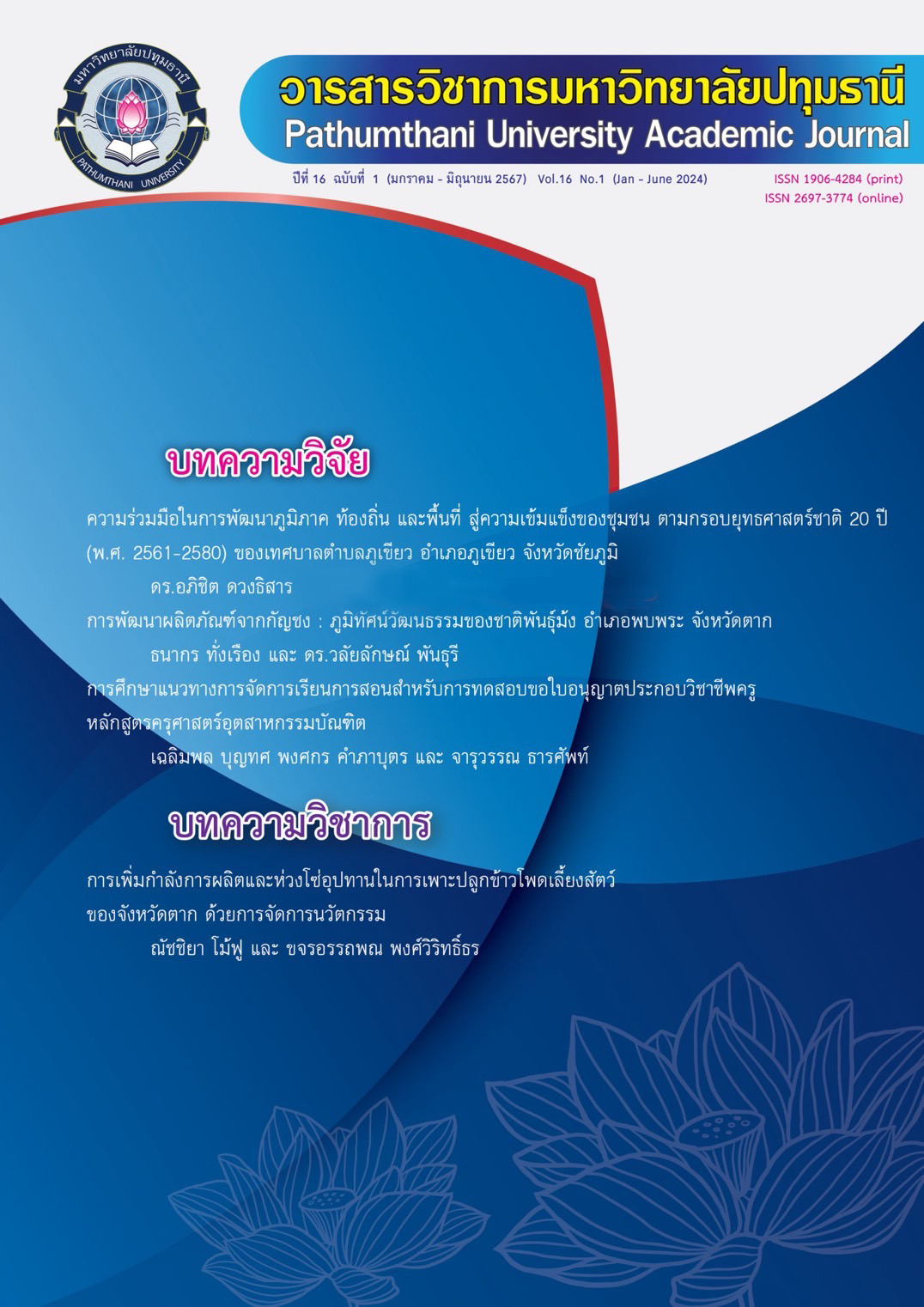THE MARKETING MIX INFLUENCES THE PURCHASING DECISIONS OF PROCESSED FRUIT PRODUCTS AS EVIDENCED BY THE CASE STUDY OF DOI LUANG PROCESSING FARMERS COMMUNITY ENTERPISE IN CHIANG DAO DISTRICT CHIANG MAI PROVINCE
Keywords:
Marketing Mix , Purchase Decision , Processed Fruit ProductsAbstract
The primary objective of this study is to explore the marketing mix factors that affect the decision-making process when purchasing processed fruit products, with a specific focus on the Doi Luang Processing Farmers Community Enterprise situated in Chiang Dao District, Chiang Mai Province. The population and sample pool consist of 400 consumers who have previously purchased processed fruit from this enterprise. The sample size was determined using the Cochran formula, accounting for a 5% sample error at a 95% confidence level due to the unknown exact population size. Data collection was executed through the distribution of questionnaires, and subsequent statistical analysis was carried out using specialized software. The analysis involved deriving frequencies, percentages, averages, and standard deviations. Furthermore, hypothesis testing was conducted through multiple regression analysis. The study's findings revealed a generally positive perception regarding the influence of the marketing mix on purchasing decisions for processed fruit products from the Doi Luang Processing Farmers Community Enterprise. Notably, attributes related to product quality, pricing strategies, and distribution channels garnered the highest ratings, with sales promotion also receiving favorable feedback.
Moreover, demographic variables such as age, marital status, occupation, education level, and monthly income were identified as significant influencers on the purchasing decision process for processed fruit products. Specifically, two elements of the marketing mix, namely product (X1) and distribution channel (X3), exhibited a positive impact, as evidenced by coefficients of 0.905 and 0.103, respectively. However, variables such as price (X2) and marketing promotion (X4) were not found to exert a significant influence on purchasing decisions regarding processed fruit products. In summary, the predictive equation for understanding purchasing decisions concerning processed fruit products from the Doi Luang Processing Farmers Community Enterprise in Chiang Dao District, Chiang Mai Province, can be expressed as follows: Y = -0.125 + 0.905X1 + 0.103X3.
References
ขจรอรรถพณ พงศ์วิริทธิ์ธร และคณะ. (2560). “ส่วนประสมทางการตลาดที่มีผลต่อการตัดสินใจเลือกซื้อผลิตภัณฑ์ ของร้านกาแฟอาข่า อาม่า”. Journal of Business, innovation, and Sustainability. ปีที่ 3 ฉบับที่ 2. หน้า 65-78.
ยุพาภรณ์ ชัยเสนา และคณะ. (2565). “การพัฒนากลยุทธ์การบริหารจัดการเพื่อสร้างความได้เปรียบทางการแข่งขันของวิสาหกิจชุมชนกลุ่มทอผ้า บ้านกุดหว้า จังหวัดกาฬสินธุ์”. วารสารศิลปศาสตร์และวิทยาการจัดการ มหาวิทยาลัยเกษตรศาสตร์. ปีที่ 9 ฉบับที่ 1. หน้า 1-15.
สำนักงานส่งเสริมวิสาหกิจขนาดกลางและขนาดย่อย. (2563). วิสาหกิจชุมชนกับวิสาหกิจขนาดกลาง และขนาดย่อย. [ออนไลน์]. เข้าถึงได้จาก: http://www.sme.go.th/Lists/Editorlnput/DispF.spx. เมื่อวันที่ 10 กันยายน 2566.
Chongko Donladpun and Vissanu Zumitzavan. (2020). “Customers’ Decision-making in Purchasing Online-Goods: A Case Study of Khon Kaen Municitpality”. Journal of Social Science and Buddhistic Anthropology. Vol. 5 No. 6. pp 118-131.
Cochran, W.G. (1977). Wiley: Sampling Techniques. (3rd ed). New York: John Wiley & Sons.
Kajornatthapol Pongwiritthon, Salinee Chaiwattanaporn, Sikarnmanee Syers, Pakphum Pakvipas, Sutheemon Chongesiriroj. (2020). “Development Guidelines of Transformational Leadership of the School Administrator of Schools in Special Economic Zone: Chiang Rai”. Journal of Legal Entity Management and Local Innovation. Vol. 6 No. 6. pp 1-15.
Downloads
Published
How to Cite
Issue
Section
License
Copyright (c) 2024 KAJORNATTHAPOL PONGWIRITTHON

This work is licensed under a Creative Commons Attribution-NonCommercial-NoDerivatives 4.0 International License.
บทความที่ได้รับการตีพิมพ์เป็นลิขสิทธิ์ของวารสารมหาวิทยาลัยปทุมธานี
ข้อความที่ปรากฎในบทความแต่ละเรื่อง เป็นความคิดเห็นส่วนตัวของผู้เขียน กองบรรณาธิการไม่จำเป็นต้องเห็นด้วยเสมอไป และไม่มีส่วนรับผิดชอบใด ๆ ถือเป็นความรับผิดชอบของผู้เขียนแต่เพียงผู้เดียว



